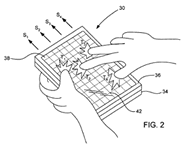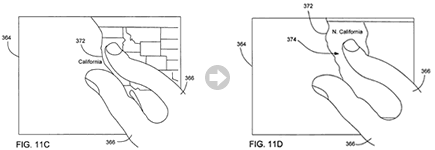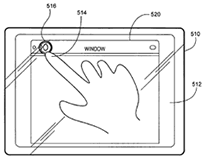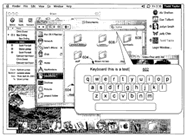Apple’s Touchscreen Ambitions
About a week ago I wrote about Jeff Han’s awesome multipoint touchscreen, and questioned if Apple was working on anything like this. Well, it turns out the answer is a resounding “Yes.” Going as far back as 2004, Apple submitted patent applications for a multipoint touchscreen, gestures for a multipoint touchscreen (including the “pinch” gesture), and other important touchscreen related stuff. So, yeah…pretty sweet…
Read on for a summary of Apple’s more interesting patent application with lots of help from hrmph.com.
It’s worth pointing out that patent
applications can be pretty dry, so I’ve
picked some highlights from some of the most
interesting and telling patent applications.
For the complete list of Apple’s patent
applications go right to the source.

Multipoint Touchscreen (20060097991)
Filed: May 6, 2004 | Published: May 11,
2006
A touchscreen that is able to “detect
multiple touches or near touches that occur
at the same time and at distinct locations.”
More info at hrmph.com

Gestures for touch sensitive input devices (20060026521)
Filed: July 30, 2004 | Published: February
2, 2006
Describes the “pinch” zoom gesture
where pinching two fingers together zooms
out and spreading two fingers apart zooms
in. Also describes using two fingers to pan
and rotate. A number of other gestures are
also described, for things like scrolling
and page navigation.
More info at hrmph.com

Visual Expander (20060022955)
Filed: August 26, 2004 | Published: February
2, 2006
This is essentially enlarging or zooming controls
as the user’s finger approaches them.
More info at hrmph.com
Activating virtual keys of a touch-screen virtual keyboard (20060085757)
Filed: September 16, 2005 | Published: April
20, 2006
This patent application describes methods
for determining which key the user means to
press on an onscreen keyboard.
More info at hrmph.com

Virtual input device placement on a touch screen user interface (20060033724)
Filed: September 16, 2005 | Published: February
16, 2006
This application describes performing text
input and other application controls using
a touchscreen, for example, easily entering
in text into a search field.
Proximity detector in handheld device (20060161870)
Filed: September 30, 2005 | Published: July
20, 2006
This document essentially describes displaying
a control on a touchscreen as the user’s
finger approaches the screen.
Electronic Device – Design Patent (D504,889)
May 10, 2005
Then of course there’s Apple’s
design patent for a device that looks an awful
lot like a tablet computer. It’s worth
pointing out that this patent is only for
the design of the device and nothing more.
So while it’s not totally meaningless,
it still doesn’t indicate nearly as
much about an eventual product as the patent
applications.
So what does all this mean?
Many of these patents describe technology that has never before seen in a consumer product. So when this technology does drop, it’ll do more than rattle a few cages, it will impact the whole industry. The cornerstone of most of Apple’s touchscreen related patents is a touchscreen that can detect multiple touch points simultaneously. This alone will be a huge change, as previous tablet computers and PDAs only captured one touch point at a time; limiting the user’s finger to emulate a mouse. Creating a multipoint touchscreen that doesn’t send the price of the product through the roof will certainly be a challenge. However, if Apple is able to create a product in which all this technology works in top form and is on par with the cost of current products, it will be the beginning of the end for the old keyboard-mouse-display arrangement and usher in an era in which using a computer is not only more natural but more comfortable.
Future products?
The drawings in the patent applications show a device that resembles a large iPod and a device closer to size of standard tablet PC, but without the keyboard. Based on the rumor mill, it seems likely that the next generation iPod will be the first touchscreen device Apple delivers. This seems like a wise approach given that there really isn’t much consumer demand for better tablet PCs. So, Apple can use the touchscreen iPod to asses the popularity of the interface and possibly even create demand for more touchscreen devices. If the touchscreen iPod is a hit, a tablet computer won’t be far behind. If the response is only lukewarm there may be an intermediate product, such as a larger iPod that also supports some new functionality (web browsing, e-mail, chat) but falls short of being a full computer.
Whether or not the iPod uses a multipoint touchscreen or not is an interesting question. While a multipoint touchscreen iPod will do a better job of introducing the technology to customers, it may increase the price too much. Also, one could argue that given the simple functionality of the iPod, a multipoint touchscreen is unnecessary and could come off as a sort of gimmick.
Regardless of the actually timing and ordering of the products, touchscreen computing certainly seems to be the way Apple is heading.
So what might some features be of an Apple tablet:
1. You’ll be able to use all 10 fingers
and possibly even more so that multiple users
can use the computer at once.
2. There will be intuitive gestures for performing
basic operations like scrolling, panning,
resizing and zooming.
3. The applications and devices will seem
to anticipate your touch by displaying controls
as your finger approaches the screen.
4. Text entry won’t be horrifically
painful, but it probably won’t be fast
either.
5. It won’t be difficult to press small
buttons or manipulate small objects on the
screen using your finger instead of a stylus.